Experiences and Challenges in Fatality Reduction on Polish Roads
Abstract
1. Introduction
- RQ1. What are the approaches to road safety programming that can be recognised as effective?
- RQ2. Is it possible to adopt a general concept of how a country’s road safety changes depending on its level of socioeconomic development?
- RQ3. What factors should be considered when developing long-term road safety forecasts for the purposes of strategic road safety programming?
- RQ4. What methods should be used in the strategic analysis of a country’s road transport system development in the aspect of road safety?
- PQ1. What strategic goals can be adopted in selected reference periods (2030 and 2050) for further road safety programming in Poland?
- PQ2. Which groups of strategic actions should be taken to achieve strategic goals?
2. Overview of Road Safety Concepts
3. Methodology—Towards Safer Roads in Poland
3.1. Methodology of Analysis
3.2. Polish Approach to Road Safety
3.3. Method for Estimating Fatalities in Poland
- long-term fatality forecasts nationally and regionally,
- assessing the effectiveness of proposed measures,
- selecting effective measures, and
- monitoring measures as they are implemented.
- the overall risk calculated as the nominal consequence of accidents (number of victims and accident costs) and
- the normalised risk calculated as the total consequence per population in a given area, number of vehicles registered in a given area, gross national product, length of the road network and miles travelled.
- a decrease in RFR largely depends on GDPPC (in a range of > 14.7 tho. ID/inhab.), LEI, EDI, DME, CPI and USB and
- an increase in RFR largely depends on GDPPC (in a range of < 14.7 tho. ID/inhab.), ACPC and DRP.
4. Assessing the Effects of NRSP Implementation in Poland
4.1. Road Safety in Poland—Past and Present
4.2. Assessing the Progress of Road Safety Programmes
4.3. Examples of Successes and Failures
5. Assessment of the Implementation of Vision Zero in Poland
5.1. Method of Strategic Road Safety Planning
5.2. Scenario Method for Road Safety Strategic Analysis
5.2.1. Research Method
5.2.2. Creating Scenarios
- the population will decrease by 0.4–0.8%;
- the economic potential measured with GDPPC will increase by 110–215%;
- the country’s organisational system will develop and the systematic increase in the LEI, EDI and CPI indices may be expected (Figure 10 presents the predicted changes in the indices; in order to fit the scale, the normalised CPIx was used: CPIx = 0.1⋅CPI);
- the road transport system will develop and the length of motorways and express roads LME will increase by 140–215%, which will contribute to an increase in VTK by 50–135%;
- the traffic enforcement system will improve and the number of speed cameras (FV) allowing for an automatic enforcement will increase by 35–475%; and
- road user behaviour will improve (less drunk driving and higher seatbelt usage).
5.3. Estimation of the Effects of the Individual Scenarios
- the level of road safety in the reference year (2020, 2030, 2050):
- 1.
- number of fatalities F (fatalities/year)
- 2.
- road fatality rate RFR (fatalities/1 m. inhab./year)
- the combined road safety effect resulting from the scenario in the analysis period (33 years):
- 3.
- expected, total number of fatalities SF (fatalities/33 years)
- 4.
- estimated number of people who can be saved from death (PRD) compared to the worst scenario S4 (fatalities/33 years)
- in all scenarios, in the analysed period, a decrease in the number of fatalities can be expected,
- the implementation of road safety measures according to Scenarios S.1 or S.2 may bring very good effects,
- the bad and very bad effects can be expected when the tasks are implemented according to Scenarios S.3 and S.4.
5.4. Directions of Activities Strengthening the Implementation of Vision Zero in Poland
- The activities aimed at the development of the road safety system: the adjustment of legal regulations to new challenges; the development and implementation of national, urban and regional level road safety programmes; and taking into account the activities of non-governmental organizations and social movements
- The activities aimed at the change of road user behaviour: the use of an automatic key to block the driver under the influence of alcohol (alcolock), the development of automatic supervision and speed management (speed cameras, adaptive speed management systems such as Intelligent Speed Adaptation ISA, pedestrian and bicycle protection devices and new driver training systems)
- The activities aimed at the development of innovative vehicles: the common use of winter tires; the development of devices supporting driver’s actions (maintaining given speed and distance and detecting conflict situations); and the development and implementation of autonomous vehicles, electric and hybrid vehicles, car sharing and communication between vehicles and external devices (with other vehicles (V2V), road infrastructures (V2X) and traffic control systems (V2C)).
- The activities aimed at the development of modern and safe road infrastructure: the elimination of frontal collisions by separating the roadway (more common use of 2+1, 2×2 cross sections), the elimination of side collisions by the use of safe intersections (roundabouts and intersections with traffic lights), the use of new and safer types of interchanges, the use of road safety devices (barriers, crash cushions and fencing) and devices protecting vulnerable road users (sidewalks, cycle routes and pedestrian crossings), the development of autonomous and electric vehicle-friendly infrastructures, and taking the opportunities of Intelligent Systems Transport. In order to achieve this, it is necessary to
- improve the rules and guidelines for safe road design;
- develop new technologies and use building materials and construction elements with high durability and low maintenance requirements, guaranteeing high safety levels and efficiency (taking into account the object’s life cycle); and
- develop new materials, technologies and construction elements that will enable a higher level of safety for road users.
- The activities aimed at the development of mobility management: traffic zoning, the propagation of shared spaces, the elimination of car traffic from central areas (charges, collective transport, bicycle transport and city bypass) and the application of new forms of urbanization (techno city and eco city).
6. Discussion
- in the case of the transport system environment, the demography (population P), the economy (GDPPC) and a country’s functional and organisational system (health system LEI, education system EDI and corruption level CPI), and
- in the case of road transport, the distance travelled by vehicles (VTK), the density of paved roads (DPR), the density of motorways and express roads (DME), the enforcement system quality (number of speed cameras FV) and the average road user behaviour (seatbelt usage USB and alcohol consumption ACPC).
- in all scenarios (except for the initial period for Scenarios S.3 and S.4) of the strategic actions, a decrease in the number of road fatalities is observed in the analysed period;
- in 2020, there is a risk of not achieving the objectives of the IV NRSP, as the predicted number of fatalities is in the range of 1850–3000 (compared to the target of 2000 fatalities);
- in 2030, there is a risk of not achieving the objectives of V NRSP, as the predicted number of fatalities is in the range of 650–2100 (compared to the initial target of 1000 fatalities). Thus, the goal of 1200 fatalities is the recommended target, taking into account a possible reduction that results from implementing scenario S2; and
- in 2050, a reduction in the number of fatalities to 100–750 can be expected. Taking into account the possibilities for implementation of strategic actions under Scenarios S.2 and S.3, this range narrows down to 200–300 fatalities. These numbers are close to the national expectations, but far from the recommendations of the European Commission.
7. Conclusions
- The country’s socioeconomic development has a significant impact on the road safety level, and the most important factors include the gross domestic product, the mobility of residents, the level of the organizational system development (education, health care system and corruption level), the level of safe infrastructure development and changes in traffic behaviour (speed, seat belts and alcohol consumption).
- The adopted model of road safety changes, and the proposed method of estimation of the number of fatalities constitute a substantive basis for formulating tasks and selecting priorities and directions of activities for the next road safety programming periods in Poland and in other countries.
- The effectiveness of the undertaken actions towards a higher level of road safety in Poland is the result of many factors. Both the current state of scientific knowledge and the experience of countries with the highest level of road safety indicate that the optimal effects can be achieved by applying an ambitious vision and a systemic approach to achieving its objectives. The basic principles of such an approach indicate the key role of a precisely defined, clear philosophy of action based on scientific foundations, not myths and common opinions.
- Despite the fact that many road safety programme activities are carried out, the implementation of the NRSP 2020 objectives is at risk as the results are so far less than expected: the pace of the decline in the number of fatalities is lower than expected and the pace of decline in the number of seriously injured is very small, almost imperceptible. Therefore, undertaking actions by the European Commission in order to reduce the number of seriously injured, which is about ten times more than the fatalities, should be considered a proper and strongly expected solution.
- The application of the scenario method to assess the strategic objectives and directions of strategic activities helped to determine how the method should be used for road safety analyses. In addition, the method helped to clarify the objectives and to assess the effectiveness of the scenarios of strategic activities.
- The analysis shows that with the use of supportive and advanced measures, it is possible to significantly reduce the number of fatalities in subsequent programming periods and to achieve the Vision Zero assumptions in several dozen years.
- Poland’s experience indicates that systematic political changes have a significant positive impact on the level of socioeconomic development, which also has a positive impact on road safety.
- In the case of Poland and other Central and Eastern Europe countries, accession to the EU brought significant benefits in terms of reduction in the number of fatalities. This was due to
- access to structural funds, which are aimed at supporting the social and economic development of regions of European Union countries and in particular the development of road infrastructure;
- the implementation of national requirements to fairly stringent European standards and in the field of road safety (Directive 2008/196/EC);
- access to international research programs and projects, research infrastructure and innovative technologies;
- the improvement of quality of life resulting from the implementation of EU’s safety and environmental protection standards;
- access to the EU’s procedures, schemas and patterns, which, if used efficiently, positively influence the progress in road safety improvement;
- the implementation of EU’s transport development strategies and road safety programmes; and
- the EU’s annual pressure on individual member states through publishing the rankings and analysing the progress in achieving road safety goals.
- Polish experiences in road safety programming were the basis for the preparation of the concept of the Integrated Transport Safety System [49].
Author Contributions
Funding
Conflicts of Interest
References
- United Nations. Transforming Our World: The 2030 Agenda for Sustainable Development. Resolution Adopted by the General Assembly on 25 September 2015; United Nations: New York, NY, USA, 2015. [Google Scholar]
- Kopits, E.; Cropper, M. Traffic fatalities and economic growth. Accid. Anal. Prev. 2005, 37, 169–178. [Google Scholar] [CrossRef] [PubMed]
- Bishai, D.; Quresh, A.; James, P.; Ghaffar, A. National road casualties and economic development. Health Econ. 2006, 15, 65–81. [Google Scholar] [CrossRef] [PubMed]
- Koren, C.; Borsos, A. From increasing to decreasing fatality figures: Where is the turning point? In Proceedings of the Eastern Asia Society for Transportation Studies, Taipei, Taiwan, 9–12 September 2013; Volume 9. [Google Scholar]
- Koornstra, M.J. Prediction of traffic fatalities and prospects for mobility becoming sustainable-safe. Sadhana 2007, 32, 365–395. [Google Scholar] [CrossRef]
- Anbarci, N.; Escaleras, M.; Register, C. Traffic fatalities and public sector corruption. Kyklos 2006, 59, 327–344. [Google Scholar] [CrossRef]
- Law, T.H.; Noland, R.B.; Evans, A.W. The sources of the Kuznets relationship between road fatalities and economic growth. J. Transp. Geogr. 2011, 19, 355–365. [Google Scholar] [CrossRef]
- Jamroz, K. Highway Engineering Risk Management Method; Gdansk University of Technology: Gdansk, Poland, 2011; ISBN 978-83-7348-342-0. [Google Scholar]
- Jamroz, K.; Smolarek, L. Road safety management tools for country strategic level. In Proceedings of the 16th RS4C Conference; DiVA, Beijing, China, 15–17 May 2013. [Google Scholar]
- Jamroz, K.; Michalski, L.; Gaca, S. Road safety programmes as an effective tool for developing system-based road safety policies. J. Konbin 2006, 1, 155–160. [Google Scholar]
- Al-Haji, G. Towards a Road Safety Development Index (RSDI). Development of an International Index to Measure Road Safety Performance; Linköping University: Norrköping, Sweden, 2005; ISBN 91-85299-70-7. [Google Scholar]
- Van Beeck, E.F.; Borsboom, G.J.; Mackenbach, J.P. Economic development and traffic accident mortality in the industrialized world, 1962–1990. Int. J. Epidemiol. 2000, 29, 503–509. [Google Scholar] [PubMed]
- Cameron, M.H.; Elvik, R. Nilsson’s Power Model connecting speed and road trauma: Applicability by road type and alternative models for urban roads. Accid. Anal. Prev. 2010, 42, 1908–1915. [Google Scholar] [CrossRef]
- Jamroz, K.; Romanowska, A.; Budzyński, M. Analysis of the impact of socio-economic development on road safety based on the example of Baltic Sea Region countries. In Proceedings of the 18th RS5C Conference, Jeju Island, Korea, 16–18 May 2018. [Google Scholar]
- Shah, S.; Ahmad, N.; Shen, Y.; Pirdavani, A.; Basheer, M.; Brijs, T. Road Safety Risk Assessment: An Analysis of Transport Policy and Management for Low-, Middle-, and High-Income Asian Countries. Sustainability 2018, 10, 389. [Google Scholar] [CrossRef]
- OECD. Targeted Road Safety Programmes; OECD: Paris, France, 1994. [Google Scholar]
- Tingvall, C.; Haworth, N. Vision Zero—An ethical approach to safety and mobility. In Proceedings of the 6th ITE International Conference Road Safety & Traffic Enforcement: Beyond 2000, Melbourne, Australia, 6–7 September 1999. [Google Scholar]
- Wegman, F. The future of road safety: A worldwide perspective. IATSS Res. 2017, 40, 66–71. [Google Scholar] [CrossRef]
- Wegman, F.; Aarts, L.; Bax, C. Advancing sustainable safety: National road safety outlook for The Netherlands for 2005–2020. Saf. Sci. 2008, 46, 323–343. [Google Scholar] [CrossRef]
- Muir, C.; Johnston, I.R.; Howard, E. Evolution of a holistic systems approach to planning and managing road safety: The Victorian case study, 1970-2015. Inj. Prev. 2018, 24, i19–i24. [Google Scholar] [CrossRef] [PubMed]
- Turner, B. Implementing the safe system approach to road safety: Some examples of infrastructure related approaches. In Proceedings of the 16th RS4C Conference DiVA, Beijing, China, 15–17 May 2013; pp. 15–17. [Google Scholar]
- Mooren, L.; Grzebieta, R.; Job, S. Safe System—Comparisons of this approach in Australia. In Proceedings of the Australasian College of Road Safety Conference “A Safe System: Making it Happen!”, Melbourne, Australia, 1–2 September 2011. [Google Scholar]
- Groeger, J.A. How Many E’s in Road Safety? In Handbook of Traffic Psychology; Elsevier: Amsterdam, The Netherlands, 2011; pp. 3–12. [Google Scholar]
- Hughes, B.P.; Anund, A.; Falkmer, T. A comprehensive conceptual framework for road safety strategies. Accid. Anal. Prev. 2016, 90, 13–28. [Google Scholar] [CrossRef] [PubMed]
- World Health Organization Global Information System on Alcohol and Health (GISAH): Levels of Consumption. Available online: https://www.who.int/gho/alcohol/consumption_levels/en/ (accessed on 18 December 2018).
- Larsson, P.; Dekker, S.W.A.; Tingvall, C. The need for a systems theory approach to road safety. Saf. Sci. 2010, 48, 1167–1174. [Google Scholar] [CrossRef]
- Lockard, J.; Welle, B.; Bray Sharpin, A.; Shotten, M.; Bose, D.; Bhatt, A.; Alveano, S.; Obelheiro, M. Sustainable & Safe. A Vision and Guidance for Zero Road Deaths; World Resources Institute: Washington, DC, USA, 2018. [Google Scholar]
- EuroRAP: Making Safe Road Design a European Transport Priority. Available online: www.eurorap.org (accessed on 4 December 2018).
- Lie, A. Vision Zero, the Importance of Energy; Trafikverket: Borlänge, Sweden, 2018.
- OECD. Towards Zero: Ambitious Road Safety Targets and the Safe System Approach; OECD: Paris, France, 2008. [Google Scholar]
- Haddon, W. The changing approach to the epidemiology, prevention, and amelioration of trauma: The transition to approaches etiologically rather than descriptively based. Am. J. Public Health 1968, 58, 1431–1438. [Google Scholar] [CrossRef]
- Burman, R.; Evans, A.J. Target Zero: A Culture of Safety. Def. Aviat. Saf. Cent. J. 2008, 22–77. [Google Scholar]
- Gerondeau, C. Road Safety in Poland; World Bank’s Report; World Bank European Community: Warsaw, Poland, 1993. [Google Scholar]
- European Commision. The 3rd European Road Safety Action Programme 2001-2010. 2000. Available online: http://www.seetoint.org/wp-content/uploads/downloads/2012/11/1044_2rswg-european-road-safety-action-plan-2001-2010-2011-2020-mrrepussard.pdf (accessed on 1 February 2019).
- Jamroz, K.; Michalski, L. Implementation of road safety programmes in Polish regions and poviats. In Proceedings of the RS4C, Warsaw, Poland, 5–7 October 2005. [Google Scholar]
- National Road Safety Council. The National Road Safety Programme 2013–2020; National Road Safety Council: Warsaw, Poland, 2013.
- Smeed, R.J. Some statistical aspects of road safety research. J. R. Stat. Soc. Ser. A 1949, 112, 1–34. [Google Scholar] [CrossRef]
- Oppe, S. Traffic Safety Developments in Poland. A Research Note; SWOV: Leidschendam, The Netherlands, 2001. [Google Scholar]
- Wachnicka, J. Mathematical models as practical tool for road fatalities forecasts on road network in regions. MATEC Web Conf. 2018, 231, 01018. [Google Scholar] [CrossRef]
- Jamroz, K.; Kadzinski, A.; Chruzik, K.; Szymanek, A.; Gucma, L.; Skorupski, J. TRANS-RISK—An integrated method for risk management in transport. J. Konbin 2010, 1, 2009–2220. [Google Scholar] [CrossRef]
- Brüde, U.; Elvik, R. The turning point in the number of traffic fatalities: Two hypotheses about changes in underlying trends. Accid. Anal. Prev. 2015, 74, 60–68. [Google Scholar] [CrossRef]
- Lord, D.; Persaud, B.N. Estimating the safety performance of urban road transportation networks. Accid. Anal. Prev. 2004, 36, 609–620. [Google Scholar] [CrossRef]
- Kononov, J. Exploratory examination of the functional form of Safety Performance Functions of urban freeways. Transp. Res. Board J. Transp. Res. Rec. 2008, 1–19. [Google Scholar]
- Cafiso, S.; D’Agostino, C. Safety Performance Function for Motorways using Generalized Estimation Equations. Procedia Soc. Behav. Sci. 2012, 53, 900–909. [Google Scholar] [CrossRef]
- United Nations Development Programme Human Development Reports. Available online: http://www.hdr.undp.org/ (accessed on 18 December 2018).
- Transparency International Corruption Perceptions Index. Available online: https://www.transparency.org/research/cpi/overview (accessed on 18 December 2018).
- Jamroz, K. Macro model of seat belt use by car occupants. Transp. Probl. 2013, 8, 103–114. [Google Scholar]
- Jamroz, K.; Kustra, W.; Budzynski, M.; Zukowska, J. Pedestrian protection, speed enforcement and road network structure the key action for implementing Poland’s Vision Zero. Transp. Res. Procedia 2016, 14, 3905–3914. [Google Scholar] [CrossRef]
- Krystek, R.; Michalski, L.; Żukowska, J.; Jamroz, K. Road safety within the “Integrated System of Transport Safety”. In Proceedings of the 16th RS4C Conference, DiVA, Beijing, China, 15–17 May 2013. [Google Scholar]
- Wegman, F. Observations of Polish road safety progress with GAMBIT. In Proceedings of the TRB Annual Meeting, Washington, DC, USA, 21–25 January 2017. [Google Scholar]
- Gaca, S.; Kiec, M. Speed Management for Local and Regional Rural Roads. Transp. Res. Procedia 2016, 14, 4170–4179. [Google Scholar] [CrossRef]
- Jamroz, K.; Gaca, S.; Michalski, L.; Kieć, M.; Budzyński, M.; Gumińska, L.; Kustra, W.; Mackun, T.; Oskarbska, I.; Rychlewska, J.; et al. Protection of Pedestrians. Guidelines for Pedestrian Traffic Organizers; National Road Safety Council: Gdansk, Poland; Warsaw, Poland; Cracow, Poland, 2014; ISBN 9788376105277. (In Polish)
- Scott Armstrong, J. Principles of forecasting: A Handbook for Researchers and Practitioners; Kluwer Academic Publishers: New York, NY, USA; Boston, MA, USA; Dordrecht, The Netherlands; London, UK; Moscow, Russia, 2001; ISBN 0-306-47630-4. [Google Scholar]
- Ansoff, H.I.; McDonnell, E.J. Implanting Strategic Management; Prentice Hall: Upper Saddle River, NJ, USA, 1990; ISBN 0134519159. [Google Scholar]
- Duus, H.J. Strategic forecasting: The management perspective. Manag. Res. Rev. 2016, 39, 998–1015. [Google Scholar] [CrossRef]
- Mietzner, D.; Reger, G. Advantages and Disadvantages of Scenario Approaches for Strategic Foresight. Int. J. Technol. Intell. Plan. 2005, 1, 220–239. [Google Scholar] [CrossRef]
- Zmud, J.; Ecola, L.; Phleps, P.; Feige, I. The Future of Mobility: Scenarios for the United States in 2030; RAND Corporation—Institute of Mobility Research: Santa Monica, CA, USA, 2013. [Google Scholar]
- Bergel-Hayat, R.; Żukowska, J. Time-Series Analysis of Road Safety Trends Aggregated at National Level in Europe for 2000–2010; Gdansk University of Technology Publishing House: Gdansk, Poland, 2015. [Google Scholar]
- Bonander, C.; Andersson, R.; Nilson, F. The effect of stricter licensing on road traffic injury events involving 15 to 17-year-old moped drivers in Sweden: A time series intervention study. Accid. Anal. Prev. 2015, 83, 154–161. [Google Scholar] [CrossRef]
- Stipdonk, H.; Wesemann, P. Long-Term Forecasts of Road Traffic Fatalities in the European Union; SWOV: Leidschendam, The Netherlands, 2007. [Google Scholar]
- EUROPEAN COMMISSION. EC-DGTM White Paper for Transport: Roadmap to a Single European Transport Area—Towards a Competitive and Resource-Efficient Transport System; EUROPEAN COMMISSION: Brussels, Belgium, 2011. [Google Scholar]
- Malta EU, Valletta Declaration on Road Safety. 2017. Available online: https://www.eu2017.mt/en/Documents/Valletta_Declaration_on_Improving_Road_Safety.pdf (accessed on 9 December 2018).
- Lovegrove, G. Road Safety Planning. New Tools for Sustainable Road Safety and Community Development; VDM Verlag Dr. Mueller e.K.: Riga, Latvia, 2007. [Google Scholar]
- Page, Y. A statistical model to compare road mortality in OECD countries. Accid. Anal. Prev. 2001, 33, 371–385. [Google Scholar] [CrossRef]
- Yannis, G.; Antoniou, C.; Papadimitriou, E.; Katsochis, D. When may road fatalities start to decrease? J. Saf. Res. 2011, 42, 17–25. [Google Scholar] [CrossRef] [PubMed]
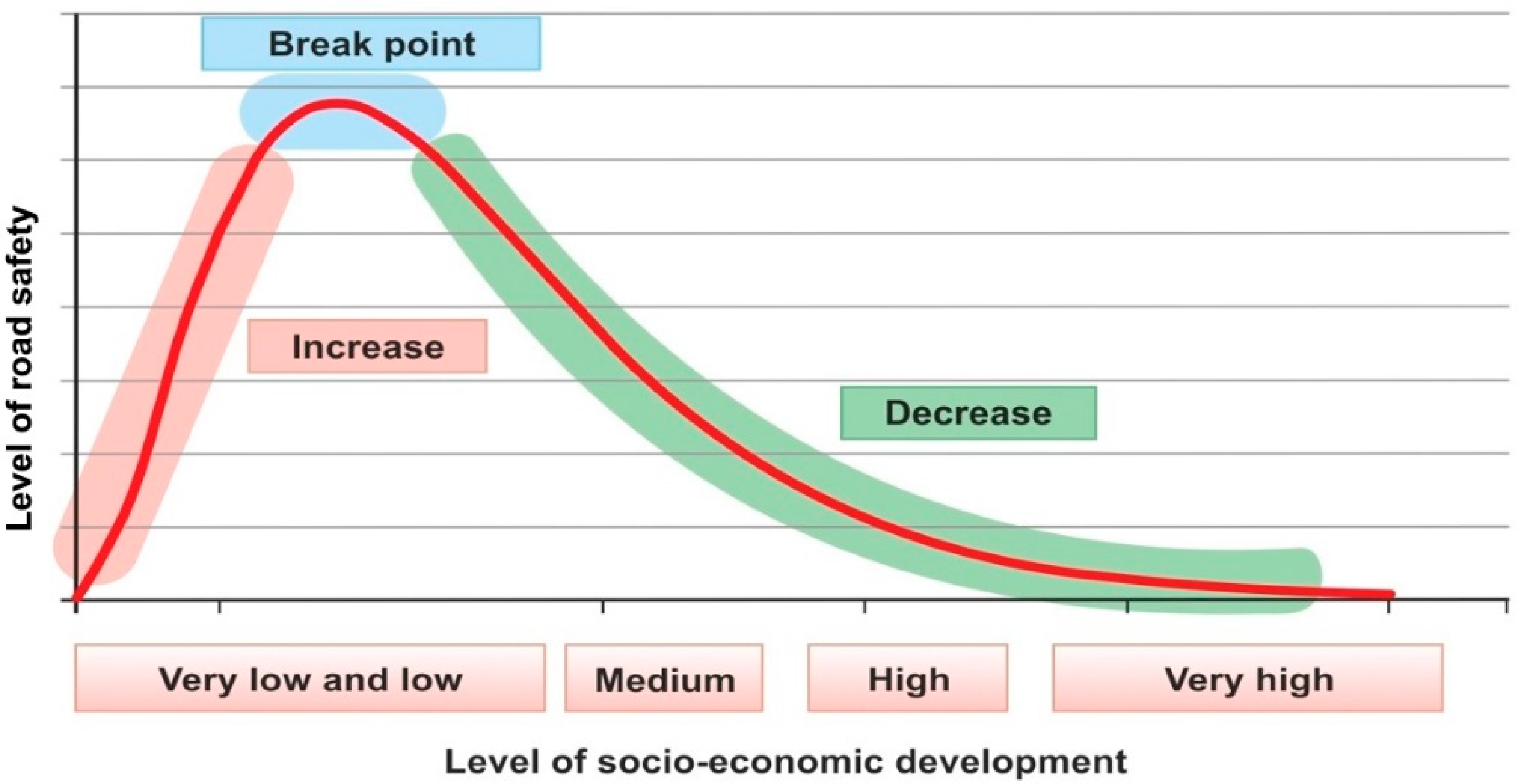
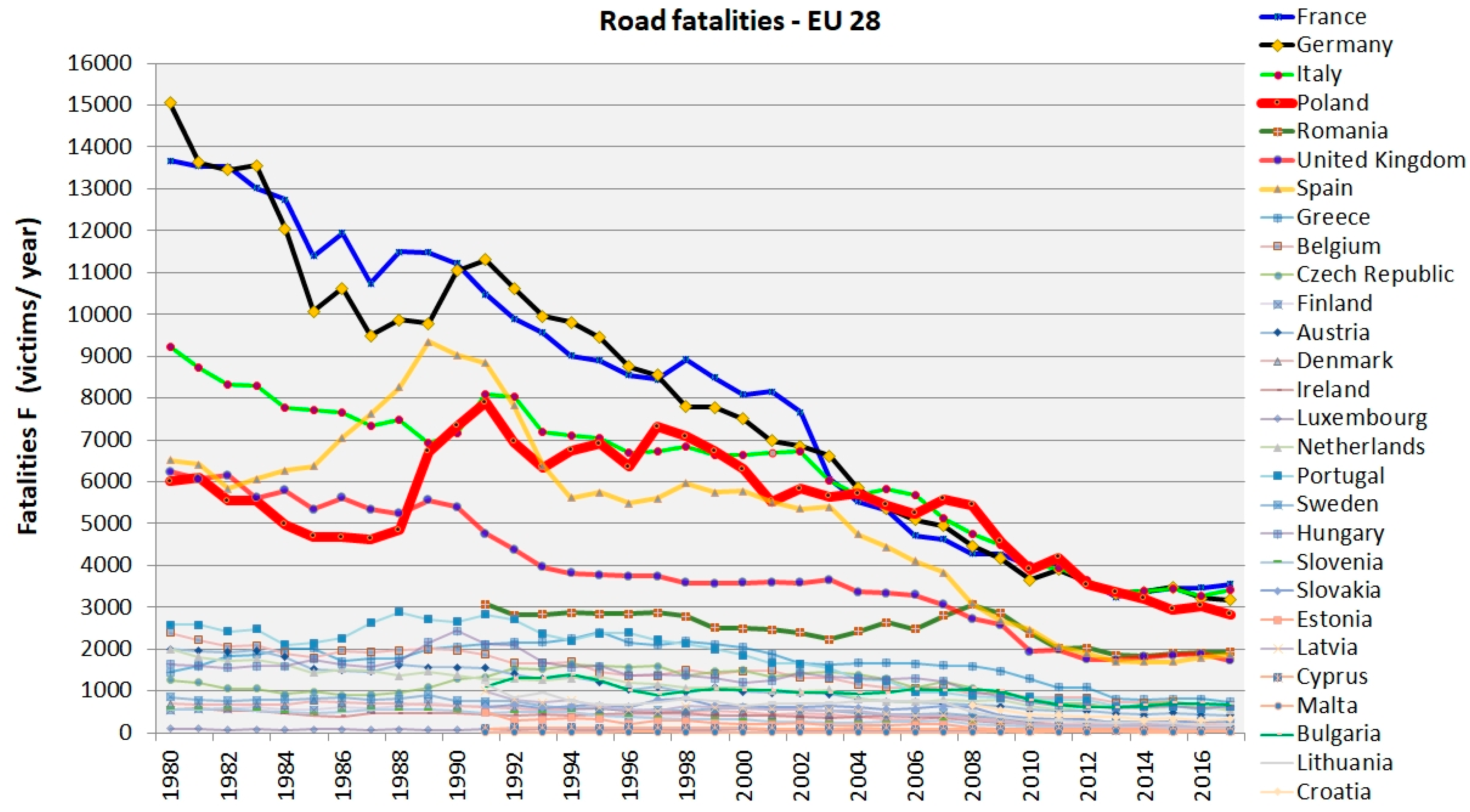




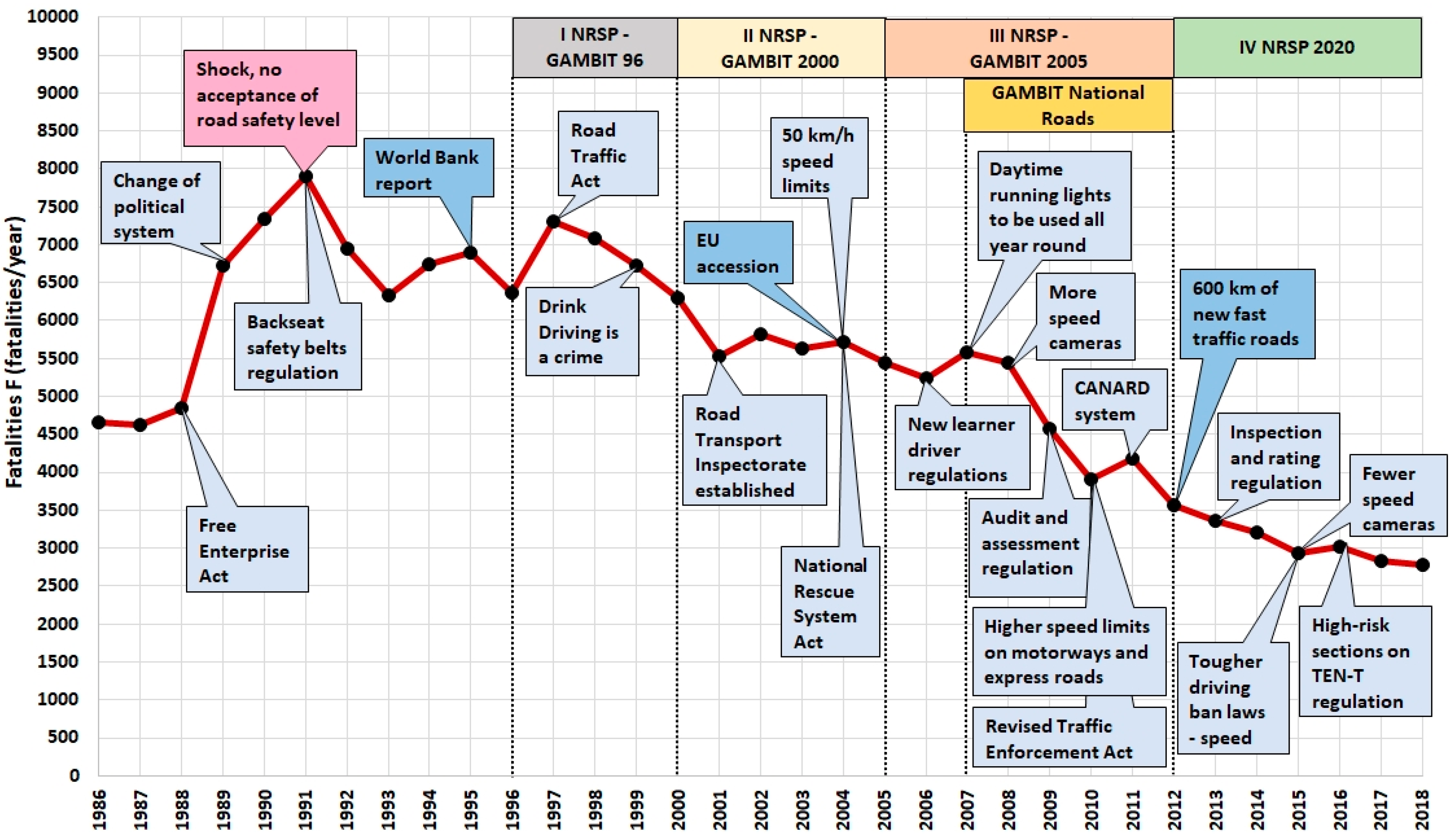
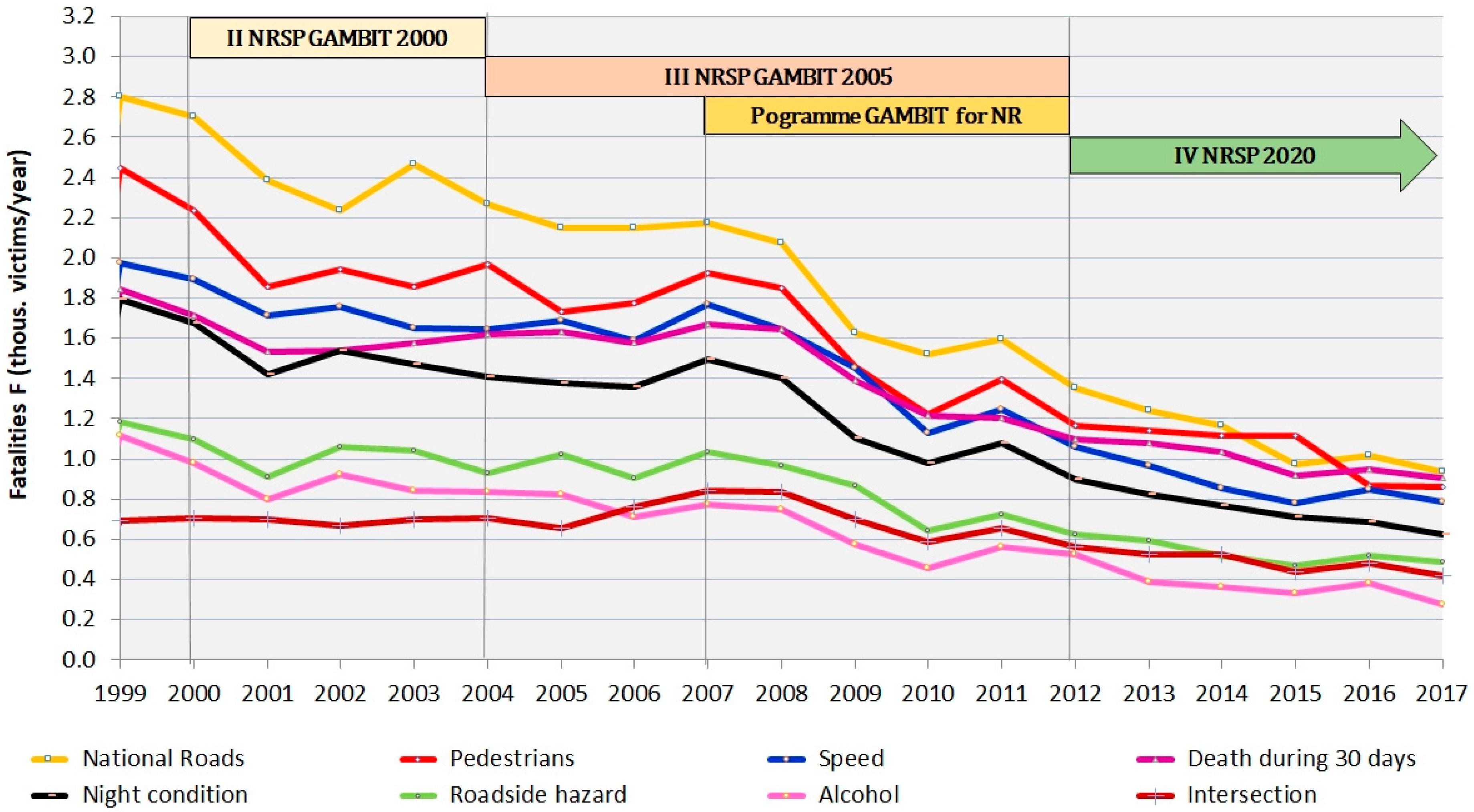
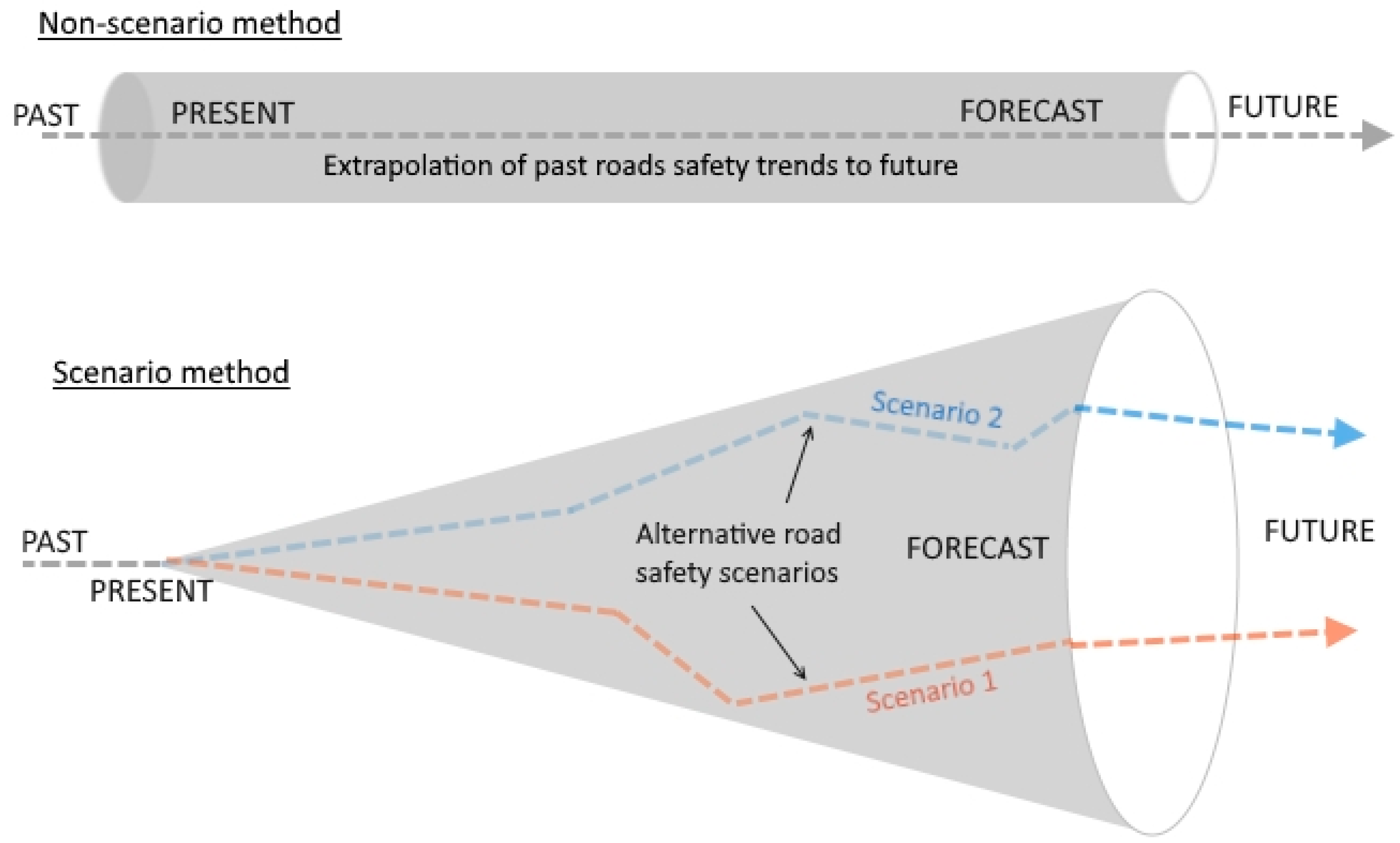
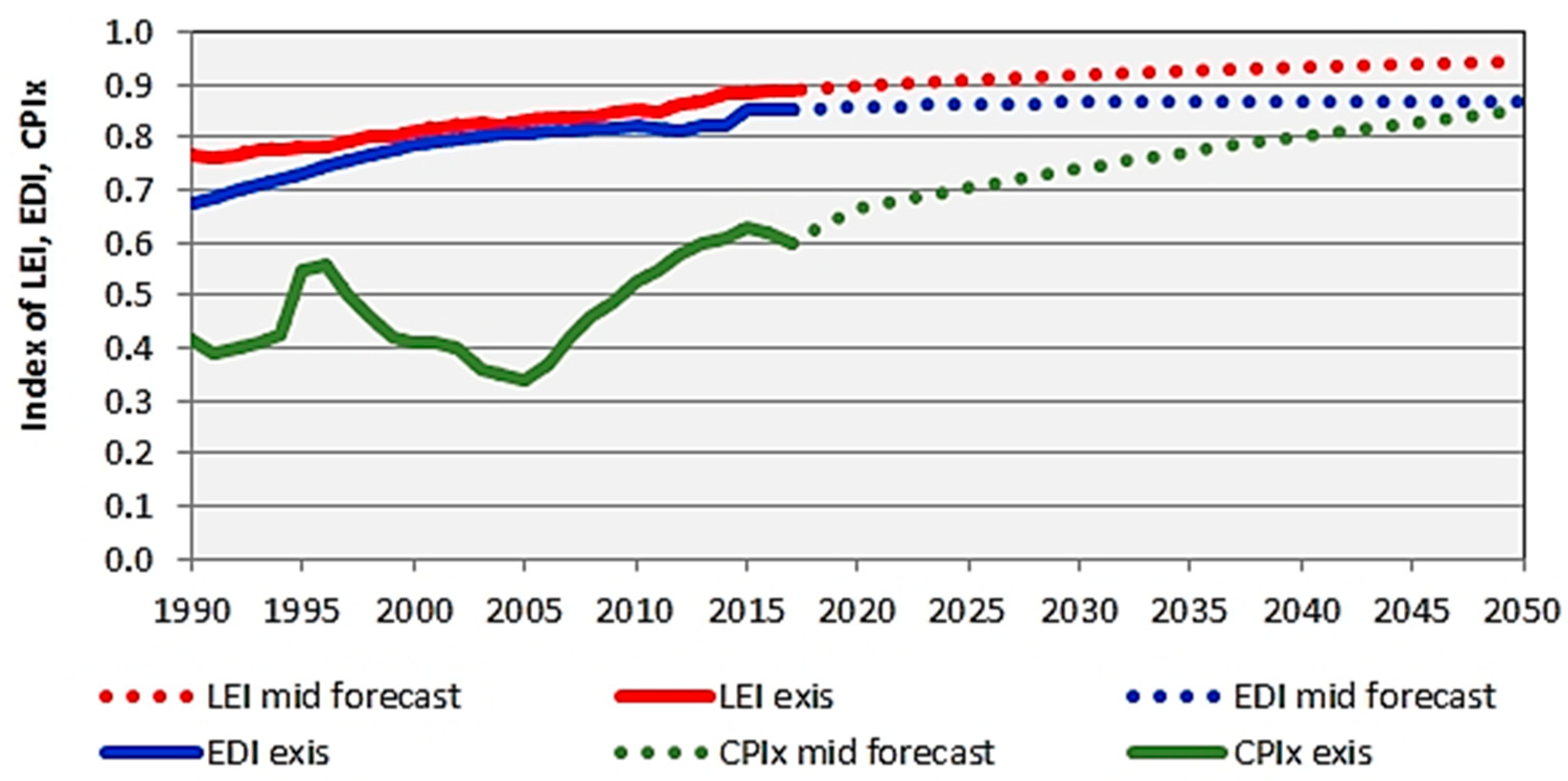
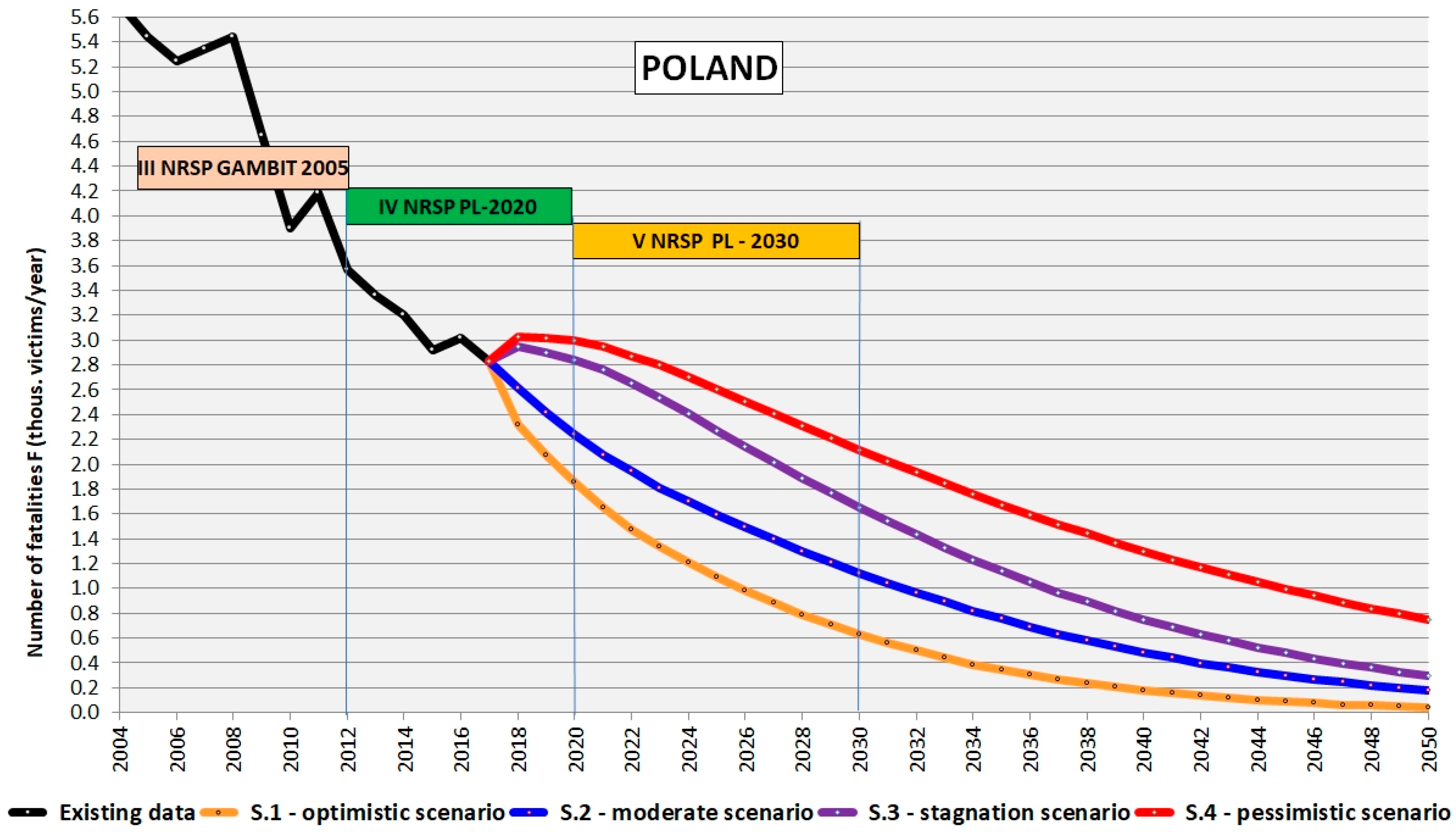
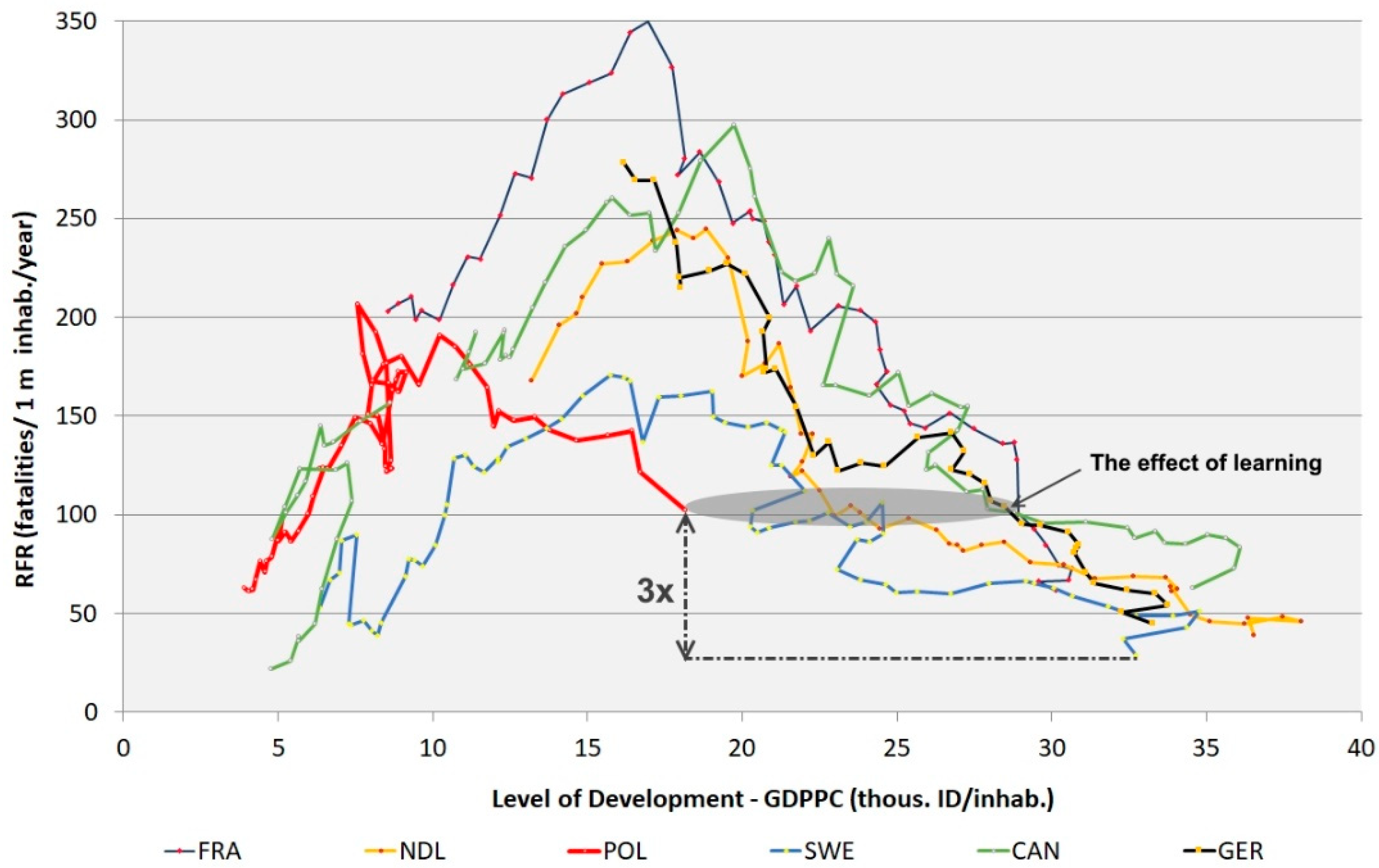
| Characteristics | Traditional Approach | Systemic Approach |
|---|---|---|
| Responsibility | Individual road user | Shared responsibility |
| Cause | Human error | System gaps |
| Actions | Reactive | Proactive |
| Interventions | Isolated | Integrated |
| Aim | Prevent road crashes and reduce casualties | Eliminate fatalities and serious injuries |
| Programme | Road Safety Policy | Strategies | Actions | |
|---|---|---|---|---|
| Working Number | Name | |||
| I NRSP | Integrated Road Safety Programme GAMBIT’96 | None | Main qualitative goal, overall fatality reduction | Grouped (integrated) |
| II NRSP | Road Safety Programme for Poland 2001–2010 GAMBIT 2000 | None | Main target (4000 fatalities in 2010), 2 objectives | Two groups of tasks |
| III NRSP | National Road Safety Programme 2005–2007–2013 GAMBIT 2005 | Vision Zero | Main target (2800 fatalities in 2013), 5 strategic objectives, Operational Programme | 4E and system development |
| IIIa | Road Safety Programme 2007–2013 GAMBIT National Roads | Vision Zero | Main target (500 fatalities on national roads in 2013); Priorities, Pilot Programme | 3 Eras, 4E |
| IV NRSP | National Road Safety Programme until 2020 | Vision Zero | Main targets (2000 fatalities and 6900 serious injuries in 2020), 5 pillars | Safe System, 4E |
| Year | Population | No. of Vehicles | Vehicle Travel Distance | No. of Fatalities | Road Fatality Rate | ||
|---|---|---|---|---|---|---|---|
| P (mln) | V (mln) | VKT (b. vkm) | F (fatalities) | RFRP (fatalities/1 m. inhab.) | RFRM (fatalities/1 m. veh.) | RRFT (fatalities/1 b. vkm.) | |
| 1988 | 37.8 | 6.9 | 113.2 | 4851 | 128.3 | 703.0 | 42.8 |
| 1991 | 38.2 | 8.6 | 108.3 | 7901 | 206.8 | 918.7 | 72.9 |
| 1997 | 38.6 | 12.3 | 127.4 | 7312 | 189.4 | 594.5 | 57.4 |
| 2001 | 38.2 | 14.7 | 148.4 | 5534 | 144.9 | 376.5 | 37.3 |
| 2007 | 38.1 | 19.5 | 220.8 | 5583 | 146.5 | 286.3 | 25.3 |
| 2015 | 38.0 | 27.4 | 3150 | 2938 | 77.3 | 107.2 | 9.3 |
| 2017 | 37.9 | 29.1 | 3300 | 2831 | 74.7 | 97.3 | 8.6 |
| NRSP | Year of Programme End | Population | No. of Fatalities | Change in No. of Fatalities | Rate of Fatality Change | Percentage Drop in Fatalities | Road Fatality Rate |
|---|---|---|---|---|---|---|---|
| P (m.) | F (fatalities) | DF (fatalities) | TF (fatalities/year) | PF (%) | RFR (fatalities/1 m. inhab) | ||
| 1995 | 38.6 | 6900 | - | - | - | 178.8 | |
| I | 1999 | 38.7 | 6730 | −170 | −43 | −2.5 | 173.9 |
| II | 2004 | 38.2 | 5712 | −1018 | −204 | −15.1 | 149.5 |
| III | 2012 | 38.1 | 3540 | −2172 | −272 | −38.0 | 92.9 |
| IV | 2017 * | 37.9 | 2831 | −709 | −142 | −20.0 | 74.7 |
| Area of Influence | Element | Variable | Projections |
|---|---|---|---|
| External environment | Demography | Population: P | Systematic reduction by 1.2–2.5 per mil annually |
| Economy | Gross domestic product per capita: GDPPC | Average increase of 2.5% per year | |
| Health system | Life expectancy index: LEI | Systematic increase | |
| Education system | Education development index: EDI | Systematic increase | |
| Organisational system | Corruption perception index: CPI | Systematic increase | |
| Societal | Alcohol consumption per capita: ACPC | Maintaining a constant level | |
| Road transport system | Travelled distance | Average vehicle kilometres travelled: VTKPC | Systematic increase of approx. 2% annually |
| Road network | Density of paved roads: DRP | Systematic increase | |
| Network of safe roads: motorways and express roads | Density of motorways and express roads: DME | Sharp increase in the next EU funding period, followed by a minimum increase | |
| Road users behaviour | Use of seat belts by drivers and car occupants: USB | Systematic increase | |
| Automatic enforcement system | Number of speed cameras: FV | Large fluctuations, depending on the current government |
| Factors Impacting on Scenarios | Social and Economic Situation Measured with GDP | ||
|---|---|---|---|
| Very Good/Good | Worse/Bad | ||
| Effectiveness of transport policy dependent on road safety | Higher | S.1 optimistic scenario | S.3 stagnation scenario |
| Low | S.2 moderate scenario | S.4 pessimistic scenario | |
| Strategic Variables | Unit | Year/Period | Scenario | ||||
|---|---|---|---|---|---|---|---|
| S1 | S2 | S3 | S4 | ||||
| Population | P | m.inhab./ year | 2020 | 36.0 | 37.8 | 37.8 | 37.9 |
| 2030 | 33.7 | 36.8 | 36.8 | 37.5 | |||
| 2050 | 29.6 | 33.0 | 33.0 | 36.6 | |||
| Gross Domestic Product per capita | GDPPC | thous. ID/inhab./ year | 2020 | 29.5 | 27.9 | 26.0 | 26.0 |
| 2030 | 62.5 | 38.5 | 33.0 | 33.0 | |||
| 2050 | 73.8 | 62.5 | 50.5 | 50.5 | |||
| Vehicle kilometres travelled | VTK | b. vkm/ year | 2020 | 330.4 | 347.8 | 347.8 | 352.5 |
| 2030 | 337.1 | 382.7 | 382.7 | 393.8 | |||
| 2050 | 346.3 | 389.4 | 389.4 | 435.5 | |||
| Length of motorways and expressways | LME | thous. km/year | 2020 | 5.3 | 5.3 | 5.3 | 5.3 |
| 2030 | 7.6 | 6.9 | 6.4 | 6.4 | |||
| 2050 | 8.0 | 7.2 | 6.5 | 6.5 | |||
| Number of speed cameras | FV | items | 2020 | 400 | 400 | 250 | 250 |
| 2030 | 930 | 600 | 280 | 280 | |||
| 2050 | 1150 | 720 | 330 | 330 | |||
| Road Safety Indicators | Unit | Year/Period | Scenario | ||||
|---|---|---|---|---|---|---|---|
| S1 | S2 | S3 | S4 | ||||
| Forecasted number of fatalities | F | fatalities/year | 2020 | 1850 | 2250 | 2850 | 3000 |
| 2030 | 650 | 1150 | 1650 | 2100 | |||
| 2050 | 100 | 200 | 300 | 750 | |||
| Forecasted value of road fatality rate | RFR | fatalities/1 m. inhab./year | 2020 | 49 | 59 | 75 | 80 |
| 2030 | 17 | 30 | 45 | 58 | |||
| 2050 | 2 | 5 | 10 | 20 | |||
| Expected total number of road fatalities by 2050 | SF | thous. inhab/33 years | 2018–2050 | 24.1 | 36.5 | 50 | 64 |
| Estimated number of people who can be saved from death compared to the S4 scenario | PRD | thous. inhab/33 years | 2018–2050 | 40.0 | 27.5 | 14.0 | 0 |
© 2019 by the authors. Licensee MDPI, Basel, Switzerland. This article is an open access article distributed under the terms and conditions of the Creative Commons Attribution (CC BY) license (http://creativecommons.org/licenses/by/4.0/).
Share and Cite
Jamroz, K.; Budzyński, M.; Romanowska, A.; Żukowska, J.; Oskarbski, J.; Kustra, W. Experiences and Challenges in Fatality Reduction on Polish Roads. Sustainability 2019, 11, 959. https://doi.org/10.3390/su11040959
Jamroz K, Budzyński M, Romanowska A, Żukowska J, Oskarbski J, Kustra W. Experiences and Challenges in Fatality Reduction on Polish Roads. Sustainability. 2019; 11(4):959. https://doi.org/10.3390/su11040959
Chicago/Turabian StyleJamroz, Kazimierz, Marcin Budzyński, Aleksandra Romanowska, Joanna Żukowska, Jacek Oskarbski, and Wojciech Kustra. 2019. "Experiences and Challenges in Fatality Reduction on Polish Roads" Sustainability 11, no. 4: 959. https://doi.org/10.3390/su11040959
APA StyleJamroz, K., Budzyński, M., Romanowska, A., Żukowska, J., Oskarbski, J., & Kustra, W. (2019). Experiences and Challenges in Fatality Reduction on Polish Roads. Sustainability, 11(4), 959. https://doi.org/10.3390/su11040959






